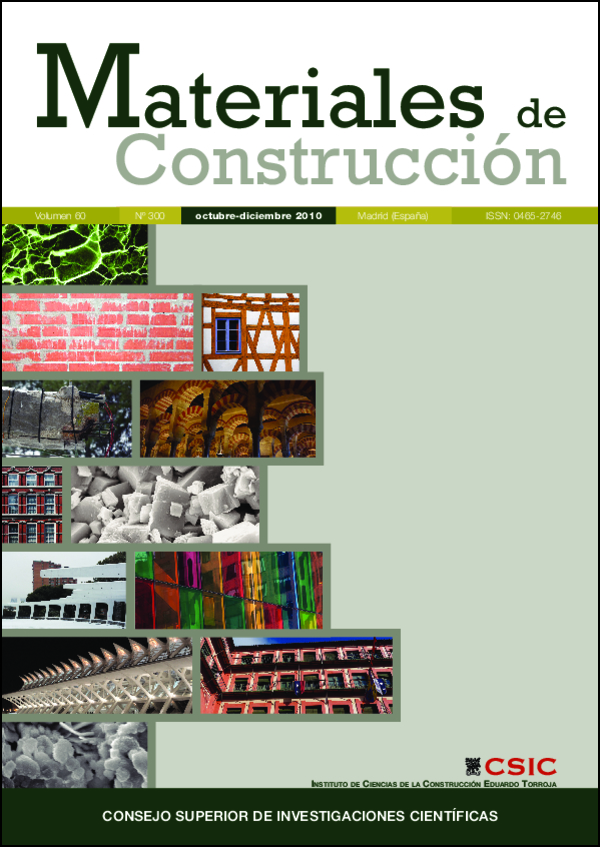Bibliometric analysis of Spanish scientific publications in the subject Construction & Building Technology in Web of Science database (1997-2008)
DOI:
https://doi.org/10.3989/mc.2010.59810Keywords:
Bibliometric analysis, Impact Factor, Spanish universities, research centers, construction & building technologyAbstract
In this paper the publications from Spanish institutions listed in the journals of the Construction & Building Technology subject of Web of Science database for the period 1997- 2008 are analyzed. The number of journals in whose is published is 35 and the number of articles was 760 (Article or Review). Also a bibliometric assessment has done and we propose two new parameters: Weighted Impact Factor and Relative Impact Factor; also includes the number of citations and the number documents at the institutional level. Among the major production Institutions with greater scientific production, as expected, the Institute of Constructional Science Eduardo Torroja (CSIC), while taking into account the weighted impact factor ranks first University of Vigo. On the other hand, only two journals Cement and Concrete Materials and Materials de Construction agglutinate the 45.26% of the Spanish scientific production published in the Construction & Building Technology subject, with 172 papers each one. Regarding international cooperation, include countries such as England, Mexico, United States, Italy, Argentina and France.
Downloads
References
(1) Rojas-Sola, J. I.; Jordá-Albiñana, B.: “Bibliometric analysis of spanish scientific publications in the subject materials science, ceramics in JCR (SCI) database (1997-2008)”, Bol. Soc. Esp. Ceram. V., vol. 48 (2009), pp. 255-260.
(2) Rojas-Sola, J. I.; Jordá-Albiñana, B.; Criado-Herrero, E.: “Bibliometric analysis of Latin American, Spanish and Portuguese Scientific Publications in the subject materials science, ceramics in JCR (SCI) database (1997-2008)”, Bol. Soc. Esp. Ceram. V. 48 (2009), pp. 297-310.
(3) Rojas-Sola, J. I.: Trabajo de investigación no publicado confeccionado a través de los resultados de acreditación, 2010. http://www.educacion.es/educacion/universidades/profesorado/cuerpos-docentes.html
(4) http://www.educacion.es/horizontales/ministerio/organismos/cneai/memorias-informes.html (recuperado el día 28 de mayo de 2010).
(5) Whitehouse, G.: “Citation rates and impact factors: should they matter?”, Brit. J. Radiol., vol. 74 (2001), pp. 1-3. PMid:11227769
(6) Baldock, C.; Ma, R. M.; Orton, C. G.: “The h index is the best measure of a scientist’s research productivity”, Med. Phys., vol. 36 (2009), pp. 1043-1045. doi:10.1118/1.3089421 PMid:19472608
(7) Davis, P. M.: “Eigenfactor: Does the principle of repeated improvement result in better estimates than raw citation counts?”, J. Am. Soc. Inf. Sci. Tec., vol. 59 (2008), pp. 2186–2188. doi:10.1002/asi.20943
(8) Garfield, E.: “How can impact factors be improved?”, Brit. Med. J., vol. 313 (1996), pp. 411-413. PMid:8761234 PMCid:2351785
(9) Amin, M.; Mabe, M. A.: “Impact factors: use and abuse”, Medicina-Buenos Aires, vol. 63 (2003), pp. 347-354.
(10) Moed, H. F.; DeBruin, R. E.; VanLeeuwen, T. N.: “New bibliometric tools for the assessment of national research performance: Database description, overview of indicators and first applications”, Scientometrics, vol. 33 (1995), pp. 381-422. doi:10.1007/BF02017338
(11) Van Raan, A. F. J.: “Advanced bibliometric methods for the evaluation of Universities”, Scientometrics, vol. 45, nº 3 (1999), pp. 417-423. doi:10.1007/BF02457601
(12) Waheed, A. A.: “Scientists turn to journals in English”, Thescientificworldjo, vol. 1 (2001), pp. 239-240. doi:10.1100/tsw.2001.57 PMid:12806094
Downloads
Published
How to Cite
Issue
Section
License
Copyright (c) 2010 Consejo Superior de Investigaciones Científicas (CSIC)

This work is licensed under a Creative Commons Attribution 4.0 International License.
© CSIC. Manuscripts published in both the printed and online versions of this Journal are the property of Consejo Superior de Investigaciones Científicas, and quoting this source is a requirement for any partial or full reproduction.All contents of this electronic edition, except where otherwise noted, are distributed under a “Creative Commons Attribution 4.0 International” (CC BY 4.0) License. You may read here the basic information and the legal text of the license. The indication of the CC BY 4.0 License must be expressly stated in this way when necessary.
Self-archiving in repositories, personal webpages or similar, of any version other than the published by the Editor, is not allowed.


















